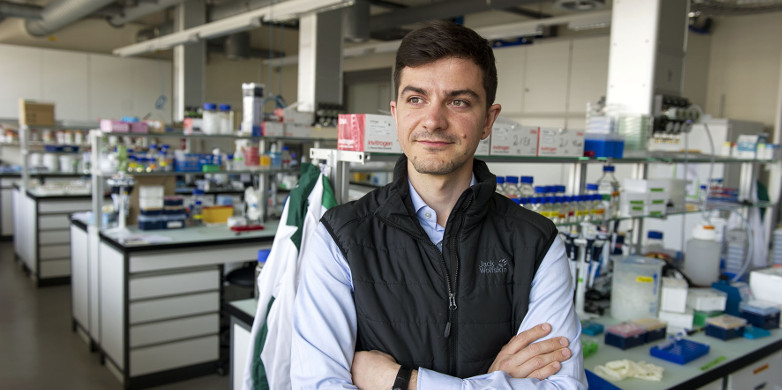New research tools
At the age of 29, biotechnologist Randall Platt has already achieved a lot: more than 1,000 research laboratories around the world use a method that he developed. But he is also the family man who recently took on a professorship at ETH.

A few pieces of furniture, a computer, a dozen books and a blackboard: Platt’s office is so minimalist it’s almost uncomfortable. “I hear that a lot, but I like it that way,” he says. “It allows me to fully concentrate on my work.” Platt came to Basel last October to work as an assistant professor in ETH’s Department of Biosystems Science and Engineering (D-BSSE). Since then, he has been working full steam ahead to establish his own group, set up the laboratory and write research grant applications. But he certainly doesn’t seem stressed.
A new role as boss
The US native is one of the youngest professors at ETH. At 29, he is not much older than his colleagues, who include one post-doctoral student, two doctoral students and one master’s student. “I still need to adjust to my new role as boss first,” he says. Sometimes he forgets that he is no longer a doctoral student, although this is not due to his fellow professors, who gave him a warm welcome. So he feels very comfortable in Basel.
Platt’s research field is biological engineering: he develops molecular tools to study how genes work. These include the genetic “cutter” CRISPR/Cas-9, which was discovered originally in microorganisms. The technology makes it possible to switch on or off any gene in an organism – and to do so far more easily and quickly than was possible with previous methods.
Platt was one of the first to apply the method to mammalian cells as part of his doctoral thesis, which he finished at Massachusetts Institute of Technology (MIT) in Boston in 2016. There he created transgenic mice, whose somatic cells produce one component of the CRISPR/Cas-9 gene cutter. These Cas-9 mice provide an ideal model for activation or deactivation of genes in individual organs or tissue, in order to study their function. The international research community also saw the value in this – more than 1,000 laboratories around the world are already working with the mouse strain.
Fascinated by the brain
The bioengineer feels good about all this: “I’m excited about the possibilities this method has opened up.” In the future, it may allow solutions to be found for many unsolved biological puzzles. He is particularly interested in the mysteries of the brain. “I’m fascinated by this organ because it can do such unbelievable things,” he says. Yet we still know so little about it. Which genes control the development of the brain? What are the genetics underlying developmental disorders such as autism? Platt is probing for answers to these questions. He recently published a scientific paper in which he defined a mouse gene associated with autistic behaviour. There are more than 800 such genes, yet their functions and the symptoms triggered by a defect in a certain gene are largely unknown. Platt wants to study all known autism genes in the mouse model. “CRISPR/Cas-9 now makes this possible,” he says. Previous methods were too time-consuming for this.
Platt hopes that a better understanding of the genetic causes of autism will contribute to the development of improved diagnostic methods and treatments. “The same is true for many other complex diseases,” he believes. This is why his research does not focus too strongly on any specific disease. “It’s not that I get bored quickly; it’s just that I like working on many different problems.” What excites him most is the development of other molecular tools that will bring about advances in research.
Family time
Platt grew up near Salt Lake City with the mountains right on his doorstep and often went skiing, mountain biking or hiking. “I would have liked to go skiing in the Alps this winter, but I didn’t manage to,” he says. Instead, when he’s not working, he spends as much time as possible with his wife and three-year-old daughter. “My top priority is having dinner every night with my family.” He also keeps most weekends free. Things used to be different: when he was working on his doctoral thesis in Boston, he spent every day for three years, including weekends, in the laboratory and did not take any holidays. That was the norm there: “It was a sort of boot camp,” he says. Platt says that he learned a lot there and would not trade that time for anything. But it is no longer an option, now that he has a family.
He is glad that he accepted the D-BSSE position, even though he had other job offers. “ETH is an excellent place to do research,” he says, and it also offers him many resources. In addition, his research complements the fields of the other professors in the department very well: “This allows us to benefit from each other.” Whether his current post will eventually become a permanent position will be decided in about five years. Until then, he still has a lot of research work ahead of him. But he’s optimistic that he will be successful and able to remain in Basel: “After living in many different places over the past several years, it would be nice to really feel at home somewhere.”
Comments
No comments yet